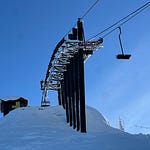Who
Doug Fish, President and Founder of the Indy Pass
Recorded on
May 9, 2022
About the Indy Pass
Here’s an overview of the 2022-23 Indy Pass suite:
And here’s what that gets you access to:

Why I interviewed him
It’s unfortunate that Steamboat, a personal favorite and one of Colorado’s most amiable mountains, has become the avatar for sticker-shock skiing, but there it is: $269 peak-day walk-up lift tickets last season. Any collateral pain is self-inflicted, and they seem committed to the process, so I don’t feel too bad hammering on them about it. Still, for readers of this newsletter, most of whom have next year’s Ikon Passes tucked into their jacket pockets by Easter, my ceaseless yammering about walk-up ticket prices can probably seem tedious and abstract, like detailing the logistical challenges of sustainable asteroid mining or the tolerable viral load of a brontosaurus: who cares?
Which is a fair question. But as the three dozen or so mega-resorts that have mainlined this triple-digit ticket tactic race toward $300 for a day of skiing, a cartoonishly absurd double universe has materialized. One that makes comparisons like this possible: for $10 more than an Ikon-oblivious skier would pay for one day at Steamboat, they could have skied 162 days at 81 ski areas with a $279 Indy Pass. Which is probably more days than most skiers rack up in a decade, and more ski areas than they visit in a lifetime.
It’s a hell of a bargain, is what I’m trying to say here, and an amazing product that the greater skiing public has, so far, failed to appreciate in large numbers. Indy predicted 400,000 redemptions this past season. The number came in at 125,000. That’s a 68.75 percent miss, which Fish attributes, in this interview, to overzealous predictions coming off the bomber Covid-induced boom season of 2020-21. What that means, for us skiers, is that this thing probably has plenty of room left to grow.
“Growth” means a couple things here. First, more resorts are incoming. Fish promised as much in this interview, even in already crowded New England. The smaller-than-expected number of redemptions means the 85 percent cut of Indy revenue that goes to the resorts was not as diluted as Fish feared it could have been (he explains how the pass operates in the interview). Plus, the new Allied Resorts discount program is broad enough that this thing could easily reach a total of 200 downhill partners (it’s not unthinkable that the addition of cross-country ski areas could push that number toward 300).
Second, more skiers are likely coming too. That’s a good thing. Numbers bring stability. Wouldn’t more skiers mean more redemptions? Yes, but it means more revenue, too, and since it’s likely that the most hardcore skiers – i.e. those most likely to redeem 30 days – are already in. Fish was comfortable enough with the average number of redemptions that he held prices steady for next season – and sales are strong as a result.
For all the attention The Storm lavishes on the Indy Pass, the product is an industry minnow, not even three years old. Yet somehow this little pass with as many annual visits as an Eagle County weekend has stapled itself to the marquee alongside the Epic and Ikon passes, a toddler in size 14 boots. It’s been astonishing to watch it grow, but it will be more amazing still to see what happens when it grows into those knee-high kicks. Fish is the first three-time guest on The Storm Skiing Podcast. Yes, because he’s generous with his time and humble in his approach, but also because he keeps coming up with new things to say, keeps making the story more compelling, keeps making us believe that this is something worth talking about.
What we talked about
Continued discussion on whether any of the Mt. Hood ski areas would ever land on Indy; redemption and sales totals versus expectations for this past ski season; how the Indy Pass works from a business point of view; how Indy is able to sign headliners like Powder Mountain and Jay Peak, which could easily align with the Epic or Ikon passes; how Cannon kept visits high even as the mountain added an enormous number of blackout dates; White Pass finds the Epkon refugees; the power of Brundage and Tamarack as a combined destination; other popular Indy combos; the New England state that will definitely get a new full Indy Pass partner before next season; expansion potential in New York; the chances of Jay staying with Indy post-sale (whenever that happens); why Indy Pass prices will stay steady for 2022-23; why the Indy Pass processing fee exists and why it’s here to stay; the Indy Switch Pass; untangling the spaghetti bowl of last year’s blackout dates; fixing the Saturday problem; thoughts on the recent additions of Kelly Canyon, Bluewood, and Ski Sawmill; the surprising appeal of Swain; finally breaking into Colorado, with Sunlight; the number of Indy Pass visits that originate out of state; thoughts on Japan; dispensing with the resort target number; losing Marmot Basin; the genesis and purpose of the Allied Resorts program; begging Doug to shift Burke to full partner status; and why Indy began including cross-country ski areas and how the response has been so far.
Why I thought that now was a good time for this interview
Since it debuted in 2008, the Epic Pass has both held steady and constantly evolved. Its premise, from the beginning, was fairly basic: unlimited access to all Vail Resorts, all the time. It launched with six mountains, and now includes access to 9,000. But almost annually, Vail has added some innovation or another: the Epic Local Pass, various versions of the Epic Day Pass, local and midweek passes, a massive lodging and on-mountain discount program, the Epic Mix tracking app, a payment plan, etc. Some of these innovations were more useful than others, but every year, we can expect something new. And that’s in addition to all the extra ski areas.
Vail, skiing’s imperial fleet, rippling with aircraft carriers and battleships and submarines, is well equipped to dream up such annual salvos of newness. It’s impressive that Indy, with a staff that would be insufficient to captain a 30-foot fishing boat, has orchestrated a commando version of this evolution. The 2019 Indy Pass cost $199 and delivered two days each at 34 ski areas. There were no blackouts and no product variation (a few partners offered an add-on pass). The next year: 52 ski areas, plus a $99 kids pass and a $129 add-on pass, available uniformly across all partner ski areas. The Indy+ Pass and a payment plan also debuted. 2021 brought a (probably too large, Fish now admits) price increase, but access to 66 ski areas at launch and an additional 17 by December, including four in Japan.
By the time Indy confirmed its 2022-23 lineup last month, the roster stood at 83 downhill partners. An ambitious cross-country initiative seeks to add more than 30 Nordic partners by winter, and the standalone XC pass is just $69 (all Indy Pass holders get the XC days). And the Allied Resorts program, announced earlier this week, ensures that nearly any ski area that’s interested can fold itself into this nationally marketed network. Fish also held prices steady, upped the renewal discount, and introduced the Indy Switch Pass to encourage Epkon snobs to reconsider.
There was plenty to talk about, is my point. And Fish, as always, accommodated, on one condition: for the love of God can we keep it to an hour?
Questions I wish I’d asked
I had meant to ask Doug about the possibility of pre-loading Indy tickets onto resort’s RFID cards, but I didn’t get to it. While he said that such integrations were “not practical,” he did provide the following statement, teasing a pretty cool tech upgrade coming for the season after next:
In partnership with our tech partner Entabeni Systems, we will be rolling out an app for the 2023-24 season [I incorrectly indicated on Twitter earlier this week that this feature would be available for next ski season] that will allow our passholders to carry their pass on their phones. Among other features, it will contain a scannable QR code that can be read at the ticket window, eliminating the need for looking them up in our system.
This app can be deployed without passing any additional costs on to our customers which we’d have to do if we issued a physical pass.
What we got wrong
I intimated that Powder Mountain was outside of the Wasatch Mountains, but the ski area in fact lies within this mountain range. I also suggested that Winter Park was a blacked-out mountain on the Ikon Pass, which it is not (on any version of the product other than the Ikon Session Pass). Doug also referred to “Wintergreen,” West Virginia. He meant Winterplace. Wintergreen is in Virginia, and is not an Indy Pass partner. Doug also referred to the marketing director of Sunlight, Colorado as “Tony Hawks” – his name is Troy Hawks, and you can (and should) follow him on Twitter here, since he’s the man who brough Indy Pass to Colorado.
Why you should buy the Indy Pass
In my head, gas is always a dollar a gallon. Even decades after that fleeting era when I pushed shopping carts for $4.35 an hour and drove a rusty pick-up, any sum over $15 to fill my gas tank baffles me. Candy bars are forever lodged at 35 cents, Hostess cupcakes at 55 cents – such were the prices when I would peddle my Huffy to the neighborhood Total in the 1980s.
I’m sure there’s a name for this pricing nostalgia. Whatever it’s called, the first best thing about the Indy Pass has become a liability, as It-Used-to-Cost-$199 Bro forever peppers social media with his waxings of this bygone era. “When the Indy Pass came out, it was under $200 and there were no blackouts,” he will complain. “And it came with a pair of Volkls and a free Subaru. Now it costs $279, there’s all kinds of blackouts, and the courtesy ‘vehicle’ is just a Shetland pony without a saddle. It’s all going to hell!”
Bros across America need to let it go. Yes, last year’s price jump was a little extreme. Fish admits as much in the interview. But it is still a very good deal – had it debuted at $279 with its current roster, it would seem like the greatest thing ever. That’s because it is. The glory in the Indy Pass is not in what it was – a coalition of 34 broadly distributed resorts – but in what it has become and is transforming into. We’re closing in on 100 partners, and we’ll likely blow right past that by the Fourth of July. God bless America. This is one damn fine product.
There is one more dumbass Bro out there that befuddles Indy’s ascension: It’s-Not-Worth-It Bro. It’s-Not-Worth-It Bro’s narrative goes something like this: yes, it’s cool that Indy put all these mountains on one pass, but they’re not the sort of ski resorts that are “worth” traveling to Montana/Idaho/Utah for or anything.

I beg your pardon? Scroll back to the chart at the top of this article. Red Lodge: 2,400 vertical feet, 1,635 acres, 250 inches of annual snowfall. Powder Mountain: 2,205 vert/8,464 acres (3,000 lift-served)/400 inches. Brundage: 1,921/1,920/320. Castle: 2,833/3,592/354. Exactly which district of Narnia do you call home if these numbers leave you yawning?
There are a lot of good reasons to buy an Indy Pass: you live within a few hours of a half dozen or more partners and are looking for a reasonably priced family winter. You have an Epkon pass but are leary of voyaging through the gates of Mount Snow/Keystone/Mammoth/Crystal on a midwinter Saturday. You’ve already visited every high-speed demo center on the continent and are looking for something different. You’re Van Life Bro and want to ski an entire winter for less than five dollars. You want to support skiing’s equivalent of craft beer (only, in this case, the indie label is a lot less expensive). Or you just love skiing and everything about it, and you want to understand this dynamic world to the fullest extent possible.
There are good reasons not to buy the Indy Pass, too: you don’t travel much, the mountains are too far, you are happy with your local, you dad’s private plane is too big to land at any mountain town airport other than Eagle. But if your goal is lots of skiing, and if you don’t exactly need a home mountain and have a little flexibility to travel, if you value novelty and don’t mind the occasional mile-long Hall double chair ride to the summit, then lock this thing in before prices increase on May 18.
More Indy Pass on The Storm Skiing Podcast:
Snow Ridge, New York GM Nick Mir
Beaver Mountain, Utah owner Travis Seeholzer
Little Switzerland, Nordic Mountain, The Rock Co-Owner Rick Schmitz
Tamarack, Idaho President Scott Turlington
Shawnee Mountain, Pennsylvania CEO Nick Fredericks
China Peak, California CEO Tim Cohee
Lutsen and Granite Peak Owner Charles Skinner
Caberfae Peaks, Michigan Co-Owner and GM Tim Meyer
Whaleback Executive Director Jon Hunt (recorded pre-Indy)
Titus Mountain Co-Owner Bruce Monette Jr. (recorded pre-Indy)
Indy Pass Founder Doug Fish (April 27, 2021 – 2nd appearance)
West Mountain, New York owners Sara and Spencer Montgomery (recorded pre-Indy)
Montage Mountain Managing Owner Charles Jefferson (recorded pre-Indy)
Granite Peak, Wisconsin GM Greg Fisher
Waterville Valley, New Hampshire GM Tim Smith
Bolton Valley, Vermont President Lindsay DesLauriers
Bousquet GM and ownership (recorded pre-Indy)
Saddleback, Maine GM Andy Shepard (recorded pre-Indy)
Jay Peak, Vermont GM Steve Wright
Cannon Mountain, New Hampshire GM John DeVivo
Indy Pass Founder Doug Fish (May 31, 2020 – 1st appearance)
Berkshire East and Catamount, Massachusetts Owner Jon Schaefer
Burk Mountain GM Kevin Mack (recorded pre-Indy)
Magic Mountain, Vermont President Geoff Hatheway
The Storm publishes year-round, and guarantees 100 articles per year. This is article 51/100 in 2022. Want to send feedback? Reply to this email and I will answer (unless you sound insane). You can also email skiing@substack.com.

















Share this post